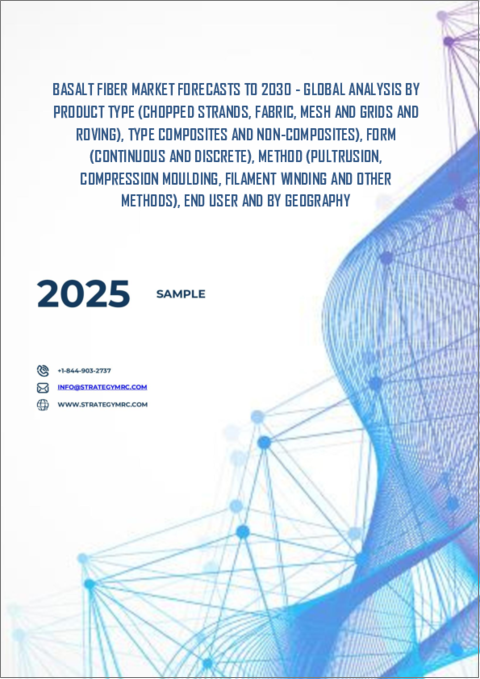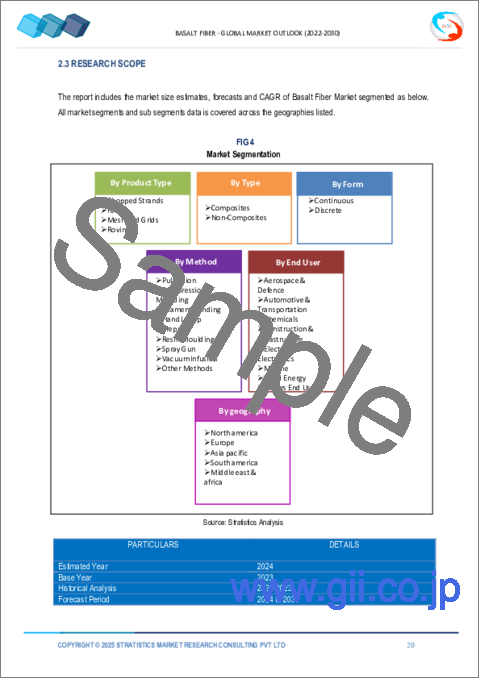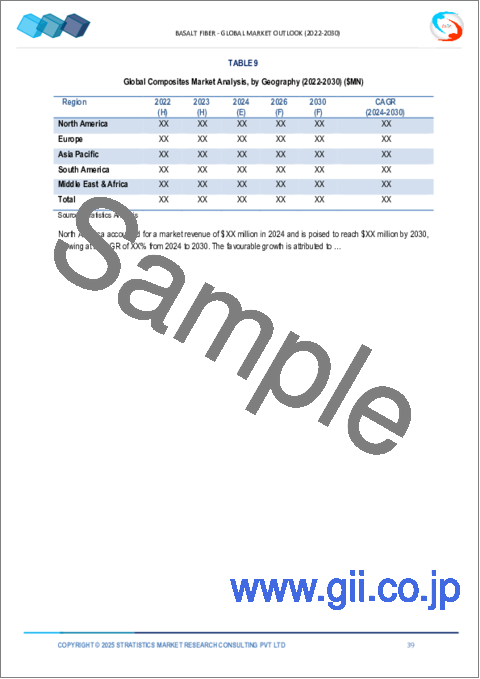|
|
市場調査レポート
商品コード
1339940
バサルト繊維市場の2030年までの予測- 製品タイプ別、タイプ別、形態別、方法別、エンドユーザー別、地域別の世界分析Basalt Fiber Market Forecasts to 2030 - Global Analysis By Product Type, Type (Composites and Non-Composites), Form, Method, End User and By Geography |
||||||
カスタマイズ可能
|
|||||||
| バサルト繊維市場の2030年までの予測- 製品タイプ別、タイプ別、形態別、方法別、エンドユーザー別、地域別の世界分析 |
|
出版日: 2023年08月01日
発行: Stratistics Market Research Consulting
ページ情報: 英文 175+ Pages
納期: 2~3営業日
|
- 全表示
- 概要
- 図表
- 目次
Stratistics MRCによると、世界のバサルト繊維市場は2023年に3億2,510万米ドルを占め、予測期間中にCAGR 14.5%で成長し、2030年には8億3,900万米ドルに達する見込みです。
バサルト繊維と呼ばれる玄武岩から作られる製品は、炭素繊維やガラス繊維の代替品として使用されます。玄武岩を高温で溶かすことで、バサルト繊維が作られます。輝石とカンラン石や斜長石などの鉱物がこの物質を構成しています。バサルト繊維は、優れた電磁気特性、高い引張強度、高い構造信頼性、機械的特性、毒性がなく、不燃性です。また、熱性能の範囲も広いです。
OICAによると、2021年の世界の自動車生産台数は2020年の7,77,11,725台から8,01,45,988台へと3%以上増加しています。
市場力学:
促進要因
自動車産業からの需要増加
自動車産業は、バサルト繊維のすべての品質と特性を求めて大きく成長しています。これらの品質には、強力な機械的特性、高温への耐性、耐久性、耐薬品性、環境への優しさなどが含まれます。バサルト繊維は自動車産業において、ヘッドライナー、CNGシリンダー、燃料タンク、ブレーキパッド、クラッチプレート、排気システム、マフラーフィラー、パネル、スクリーン、タイヤカバー、織物で作られた内外装部品、熱可塑性化合物で作られた部品やコンポーネントなど、多くの部品に利用されています。これらの要素により、バサルト繊維市場はおそらく今後数年で世界的に拡大すると思われます。
抑制要因
用途に関する情報不足
バサルト繊維の生産は、いくつかの問題によって妨げられています。バサルト繊維の生産に必要な、高品質で正しい化学組成を持つ玄武岩の岩石が採れる場所は、東欧では限られています。さらに、Sガラス繊維やEガラス繊維に比べて多くの利点があるにもかかわらず、バサルト繊維は、その用途に関する知識や明確さが不足しているため、現在多くの用途で商業的に使用されていないです。
機会:
リサイクル可能で環境に優しい材料の使用増加
環境にやさしく、リサイクルしやすい繊維強化複合材料は常に求められています。これは、数々の新しく厳しい政府の法律や規制の結果です。環境に安全なリサイクル可能な製品に切り替える消費者が増えています。米国、日本、ドイツなど一部の先進国では、環境に優しい商品やバイオベースの素材を優先して、石油ベースの製品の使用を段階的に減らしています。さらに、政府の規則や規制により、建設、インフラ、自動車、輸送など多くの最終用途産業でバサルト繊維やその他の天然繊維の使用が増加すると予想されます。
脅威
高コストと技術課題
バサルト繊維は、Eガラス、炭素繊維、アラミドよりも高価です。その不透明な性質のため、玄武岩はガラスよりも均一に加熱するのが非常に難しく、溶融材料を長時間貯留槽に保管したり、2段階の加熱システムを使用するなどの製造上の工夫が必要となります。透明なガラスとは逆に、不透明な玄武岩は赤外線を透過するのではなく、吸収します。そのため、ガラス炉の標準的なオーバーヘッドガスバーナーでは、玄武岩混合物を均一に加熱することが難しいです。バサルト繊維の製造に関わる技術的な難しさが、市場の拡大を制限しています。
COVID-19のインパクト:
世界的に、COVID-19の発生はバサルト繊維のサプライチェーンに悪影響を及ぼしました。多くの国でロックダウンが発生した結果、原料の納入が遅れ、世界の市場拡大に影響を与えました。消費者の消費力が低下し、航空、建築、自動車産業に影響を与えました。その結果、バサルト繊維の市場は限定的な成長にとどまっています。
予測期間中、複合材料分野が最大になる見込み
優れた耐久性、腐食性要素への耐性、部門を超えた高温耐性により、複合バサルト繊維は高い需要があり、最大の市場シェアを記録すると予想されます。また、自動車や航空宇宙分野で軽量素材が普及するにつれて、複合バサルト繊維は軽量化しながら構造物の健全性を保つのに役立つため、需要が高まっています。さらに、炭素繊維やガラス繊維のような他の複合材料よりも手頃な価格でありながら、それが環境にもたらす利点に対する消費者の意識が高まった結果、市場は拡大しています。
予測期間中にCAGRが最も高くなると予想されるのは、建設・インフラ分野です。
高強度対重量比、耐薬品性、耐腐食性、低熱伝導性、電気・磁気伝導の欠如など、バサルト繊維複合材料の特徴的な特性の組み合わせにより、建設・インフラ産業では徐々に鉄鋼に取って代わりつつあり、この分野は急速な成長が見込まれています。バサルト繊維は、組み立て式の住宅やビル、冷たい床暖房プレート、防火間仕切り、防火壁、防火ドアなど、様々な建設プロジェクトに使用されています。また、補強鉄筋、引抜成形耐力プロファイル、二軸および三軸バサルト繊維織物、玄武岩補強メッシュ、バサルト繊維補強コンクリートなどにも続いており、その成長余地は広いです。
最大のシェアを持つ地域:
予測期間中、アジア太平洋地域が世界市場を独占すると予想されます。中国、日本、インドなどの国々における建築・建設活動の活発化は、アジア太平洋地域におけるバサルト繊維の需要を増加させると予想されます。さらに、同地域では再生可能エネルギーを重視する傾向が強まっているため、風力タービンの設置台数が増加しており、これがアジア太平洋地域の市場拡大にさらに貢献しています。
CAGRが最も高い地域:
北米も世界のバサルト繊維市場のかなりの部分を占めています。ノースカロライナ州シェルビーにある世界最大のバサルト繊維製造施設は、Maficからの受注を開始しました。それぞれの専門知識を組み合わせることで、両社はバサルト繊維の特殊な機械的特性を改善するために協力します。さらに、この地域の市場は、急速なインフラ整備とテクニカル・テキスタイル分野の成長により、収益成長が見込まれています。
無料カスタマイズサービス:
本レポートをご購読のお客様には、以下のいずれかの無料カスタマイズオプションをご提供いたします:
- 企業プロファイル
- 追加市場プレイヤーの包括的プロファイリング(3社まで)
- 主要企業のSWOT分析(3社まで)
- 地域セグメンテーション
- 顧客の関心に応じた主要国の市場推計・予測・CAGR(注:フィージビリティチェックによる)
- 競合ベンチマーキング
- 製品ポートフォリオ、地理的プレゼンス、戦略的提携に基づく主要企業のベンチマーキング
目次
第1章 エグゼクティブサマリー
第2章 序文
- 概要
- ステークホルダー
- 調査範囲
- 調査手法
- データマイニング
- データ分析
- データ検証
- 調査アプローチ
- 調査ソース
- 1次調査ソース
- 2次調査ソース
- 前提条件
第3章 市場動向分析
- 促進要因
- 抑制要因
- 機会
- 脅威
- 製品分析
- エンドユーザー分析
- 新興市場
- 新型コロナウイルス感染症(COVID-19)の影響
第4章 ポーターのファイブフォース分析
- 供給企業の交渉力
- 買い手の交渉力
- 代替品の脅威
- 新規参入業者の脅威
- 競争企業間の敵対関係
第5章 世界のバサルト繊維市場:製品タイプ別
- チョップドストランド
- ファブリック
- メッシュとグリッド
- ロービング
第6章 世界のバサルト繊維市場:タイプ別
- 複合材料
- 非複合材
第7章 世界のバサルト繊維市場:形態別
- 継続的
- 離散
第8章 世界のバサルト繊維市場:方法別
- 引抜成形
- 圧縮成形
- フィラメントワインディング
- ハンドレイアップ
- プリプレグ
- 樹脂成形品
- スプレーガン
- 真空注入
- その他の方法
第9章 世界のバサルト繊維市場:エンドユーザー別
- 航空宇宙と防衛
- 自動車と輸送
- 化学薬品
- 建設とインフラストラクチャー
- 電気・電子
- マリン
- 風力エネルギー
- その他のエンドユーザー
第10章 世界のバサルト繊維市場:地域別
- 北米
- 米国
- カナダ
- メキシコ
- 欧州
- ドイツ
- 英国
- イタリア
- フランス
- スペイン
- その他欧州
- アジア太平洋地域
- 日本
- 中国
- インド
- オーストラリア
- ニュージーランド
- 韓国
- その他アジア太平洋地域
- 南米
- アルゼンチン
- ブラジル
- チリ
- その他南米
- 中東とアフリカ
- サウジアラビア
- アラブ首長国連邦
- カタール
- 南アフリカ
- その他中東とアフリカ
第11章 主な発展
- 契約、パートナーシップ、コラボレーション、合弁事業
- 買収と合併
- 新製品の発売
- 事業拡大
- その他の主要戦略
第12章 企業プロファイル
- Hebei Tong-Hui Technology
- Incotelogy GmbH
- Isomatex SA
- JiangSu Tian Long Continuous Basalt Fiber Co., Ltd.
- Kamenny VEK
- Mafic SA
- Mudanjiang Jinshi Basalt Fiber Co. Ltd.
- Basalt Fibers
- Russian Basalt LLC.
- Shanxi Basalt Fiber Technology Co Ltd.
- Sudaglass Fiber Technology
- Technobasalt-Invest LLC
- Zhejiang GBF
List of Tables
- Table 1 Global Basalt Fiber Market Outlook, By Region (2021-2030) ($MN)
- Table 2 Global Basalt Fiber Market Outlook, By Product Type (2021-2030) ($MN)
- Table 3 Global Basalt Fiber Market Outlook, By Chopped Strands (2021-2030) ($MN)
- Table 4 Global Basalt Fiber Market Outlook, By Fabric (2021-2030) ($MN)
- Table 5 Global Basalt Fiber Market Outlook, By Mesh and Grids (2021-2030) ($MN)
- Table 6 Global Basalt Fiber Market Outlook, By Roving (2021-2030) ($MN)
- Table 7 Global Basalt Fiber Market Outlook, By Type (2021-2030) ($MN)
- Table 8 Global Basalt Fiber Market Outlook, By Composites (2021-2030) ($MN)
- Table 9 Global Basalt Fiber Market Outlook, By Non-Composites (2021-2030) ($MN)
- Table 10 Global Basalt Fiber Market Outlook, By Form (2021-2030) ($MN)
- Table 11 Global Basalt Fiber Market Outlook, By Continuous (2021-2030) ($MN)
- Table 12 Global Basalt Fiber Market Outlook, By Discrete (2021-2030) ($MN)
- Table 13 Global Basalt Fiber Market Outlook, By Method (2021-2030) ($MN)
- Table 14 Global Basalt Fiber Market Outlook, By Pultrusion (2021-2030) ($MN)
- Table 15 Global Basalt Fiber Market Outlook, By Compression Moulding (2021-2030) ($MN)
- Table 16 Global Basalt Fiber Market Outlook, By Filament Winding (2021-2030) ($MN)
- Table 17 Global Basalt Fiber Market Outlook, By Hand Layup (2021-2030) ($MN)
- Table 18 Global Basalt Fiber Market Outlook, By Prepregs (2021-2030) ($MN)
- Table 19 Global Basalt Fiber Market Outlook, By Resin Moulding (2021-2030) ($MN)
- Table 20 Global Basalt Fiber Market Outlook, By Spray Gun (2021-2030) ($MN)
- Table 21 Global Basalt Fiber Market Outlook, By Vacuum Infusion (2021-2030) ($MN)
- Table 22 Global Basalt Fiber Market Outlook, By Other Methods (2021-2030) ($MN)
- Table 23 Global Basalt Fiber Market Outlook, By End User (2021-2030) ($MN)
- Table 24 Global Basalt Fiber Market Outlook, By Aerospace & Defence (2021-2030) ($MN)
- Table 25 Global Basalt Fiber Market Outlook, By Automotive & Transportation (2021-2030) ($MN)
- Table 26 Global Basalt Fiber Market Outlook, By Chemicals (2021-2030) ($MN)
- Table 27 Global Basalt Fiber Market Outlook, By Construction & Infrastructure (2021-2030) ($MN)
- Table 28 Global Basalt Fiber Market Outlook, By Electrical & Electronics (2021-2030) ($MN)
- Table 29 Global Basalt Fiber Market Outlook, By Marine (2021-2030) ($MN)
- Table 30 Global Basalt Fiber Market Outlook, By Wind Energy (2021-2030) ($MN)
- Table 31 Global Basalt Fiber Market Outlook, By Others End Users (2021-2030) ($MN)
Note: Tables for North America, Europe, APAC, South America, and Middle East & Africa Regions are also represented in the same manner as above.
According to Stratistics MRC, the Global Basalt Fiber Market is accounted for $325.1 million in 2023 and is expected to reach $839.0 million by 2030 growing at a CAGR of 14.5% during the forecast period. A product made from basalt rock called basalt fiber is used as a substitute for carbon and glass fiber. By melting basalt rocks at high temperatures, basalt fiber is created. Pyroxene and minerals like olivine and plagioclase make up this substance. Basalt fiber has superior electromagnetic properties, high tensile strength, high structural reliability, mechanical properties, no toxicity, and is non-combustible. It also has a good thermal performance range.
According to OICA, in 2021, the global motor vehicle production has increased from 7,77,11,725 units in 2020 to about 8,01,45,988 in 2021 which is an increase of more than 3%.
Market Dynamics:
Driver:
Rising demand from automotive industry
There is huge rise in automotive industry for all of basalt fiber's qualities and properties. These qualities include strong mechanical properties, resistance to high temperatures, durability, chemical resistance, and environmental friendliness. Basalt fiber is utilized in the automotive industry for many parts, including headliners, CNG cylinders, fuel tanks, brake pads, clutch plates, exhausting systems, muffler filler, panels, screens, tire covers, interior and exterior parts made of fabrics, and parts and components made of thermoplastic compounds. All of these elements will probably cause the basalt fiber market to expand globally in the coming years.
Restraint:
Lack of information on its uses
The production of basalt fibers is hindered by some issues. There are only a few places in Eastern Europe where basalt rocks are of high quality and have the correct chemical composition needed to produce basalt fibers. Furthermore, despite having a number of advantages over S-glass and E-glass fiber, basalt fiber is not currently being used commercially in many applications due to a lack of knowledge and clarity surrounding its applications.
Opportunity:
Rising usage of recyclable and environmentally friendly materials
Fiber-reinforced composites that are environmentally friendly and easily recyclable are in constant demand. This is a result of the numerous new, strict government laws and regulations. A growing number of consumers are switching to recyclable goods that are safe for the environment. The use of petroleum-based products is being phased out in some developed nations, such as the US, Japan, and Germany, in favor of environmentally friendly goods and bio-based materials. Moreover, the government's rules and regulations are anticipated to increase the use of basalt fiber and other natural fibers in construction, infrastructure, automotive, and transportation, among many other end-use industries.
Threat:
High cost and technical challenges
Basalt fiber is more expensive than E-glass, carbon fiber, or aramid. Due to its opaque nature, basalt is much harder to heat uniformly than glass and requires manufacturing modifications like keeping the molten material in a reservoir for a longer period of time or using a two-stage heating system. Contrary to transparent glass, opaque basalt absorbs infrared light rather than transmitting it. As a result, standard overhead gas burners in glass furnaces have trouble evenly heating the basalt mixture. The technical difficulties involved in making basalt fibers are limiting market expansion.
COVID-19 Impact:
Globally, the COVID-19 outbreak had a negative effect on the basalt fiber supply chain. The delivery of raw materials was delayed as a result of lockdowns in many nations, which had an impact on global market expansion. Consumer spending power has decreased, which has an impact on the aviation, building, and auto industries. As a result, the market for basalt fiber has experienced limited growth.
The composites segment is expected to be the largest during the forecast period
Due to the superior durability, resistance to corrosive elements, and high temperature tolerance across sectors, composite basalt fiber is in high demand and is anticipated to register the largest market share. In addition, as lightweight materials become more popular in the automotive and aerospace sectors, composite basalt fiber is becoming more in demand because it helps structures remain structurally sound while reducing weight. Furthermore, the market is expanding as a result of consumers' growing awareness of the advantages it offers the environment while still being more affordable than other composite materials like carbon and glass fibers.
The construction and infrastructure segment is expected to have the highest CAGR during the forecast period
Due to their distinctive combination of qualities, including their high strength-to-weight ratio, chemical and corrosion resistance, low thermal conductivity, and lack of electrical and magnetic conduction, basalt fiber composite materials are gradually replacing steel in the construction and Infrastructure industries, and this segment is expected to witness rapid growth. Basalt fibers are used for a variety of construction projects, including assembled homes and buildings, cold floor heating plates, fire partitions, firewalls, and fire doors. It also continues in reinforced rebars, pultruded load-bearing profiles, biaxial and triaxial basalt fabrics, basalt reinforcing meshes, and basalt fiber-reinforced concrete, where there is wide scope for their growth.
Region with largest share:
During the forecast period, the Asia-Pacific region is anticipated to dominate the global market. Growing building and construction activity in nations like China, Japan, and India is anticipated to increase basalt fiber demand in the Asia-Pacific region. Furthermore, the region's growing emphasis on renewable energy sources has increased the number of wind turbine installations, which has further contributed to the expansion of the market in this Asia-Pacific region.
Region with highest CAGR:
North America also accounts for a sizable portion of the global basalt fiber market. The world's largest basalt fiber manufacturing facility, located in Shelby, North Carolina, has started accepting orders from Mafic. By combining their respective expertise, the companies will work together to improve the special mechanical properties of basalt fiber. Additionally, the region's market is anticipated to experience revenue growth as a result of rapid infrastructure development and growth in the technical textile sector.
Key players in the market:
Some of the key players profiled in the Basalt Fiber Market include: Hebei Tong-Hui Technology, Incotelogy GmbH, Isomatex SA, JiangSu Tian Long Continuous, Basalt Fiber Co., Ltd., Kamenny VEK, Mafic SA, Mudanjiang Jinshi Basalt Fiber Co. Ltd., Basalt Fibers, Russian Basalt LLC., Shanxi Basalt Fiber Technology Co Ltd., Sudaglass Fiber Technology, Technobasalt-Invest LLC and Zhejiang GBF.
Key Developments:
- In March 2022, USDA-RD State Director Announcing $3 Million Investment with Mafic USA. Mafic USA will use a USDA Business and Industry Loan to finance the purchase of equipment to expand the capacity of its facility.
- In July 2020, Mafic USA has commenced operations at the world's largest basalt fiber production facility in Shelby, North Carolina. It is also the first such facility in North America. Last week, the company completed the highly calibrated process of starting-up the plant's furnace. This week, Mafic's team began melting basalt rock and pulling the first fiber at the plant. This marks a major step forward in the company's goal to bring basalt fiber to North American markets and to produce the product on a commercially viable scale.
Product Types Covered:
- Chopped Strands
- Fabric
- Mesh and Grids
- Roving
Types Covered:
- Composites
- Non-Composites
Forms Covered:
- Continuous
- Discrete
Methods Covered:
- Pultrusion
- Compression Moulding
- Filament Winding
- Hand Layup
- Prepregs
- Resin Moulding
- Spray Gun
- Vacuum Infusion
- Other Methods
End Users Covered:
- Aerospace & Defence
- Automotive & Transportation
- Chemicals
- Construction & Infrastructure
- Electrical & Electronics
- Marine
- Wind Energy
- Others End Users
Regions Covered:
- North America
- US
- Canada
- Mexico
- Europe
- Germany
- UK
- Italy
- France
- Spain
- Rest of Europe
- Asia Pacific
- Japan
- China
- India
- Australia
- New Zealand
- South Korea
- Rest of Asia Pacific
- South America
- Argentina
- Brazil
- Chile
- Rest of South America
- Middle East & Africa
- Saudi Arabia
- UAE
- Qatar
- South Africa
- Rest of Middle East & Africa
What our report offers:
- Market share assessments for the regional and country-level segments
- Strategic recommendations for the new entrants
- Covers Market data for the years 2021, 2022, 2023, 2026 and 2030
- Market Trends (Drivers, Constraints, Opportunities, Threats, Challenges, Investment Opportunities, and recommendations)
- Strategic recommendations in key business segments based on the market estimations
- Competitive landscaping mapping the key common trends
- Company profiling with detailed strategies, financials, and recent developments
- Supply chain trends mapping the latest technological advancements
Free Customization Offerings:
All the customers of this report will be entitled to receive one of the following free customization options:
- Company Profiling
- Comprehensive profiling of additional market players (up to 3)
- SWOT Analysis of key players (up to 3)
- Regional Segmentation
- Market estimations, Forecasts and CAGR of any prominent country as per the client's interest (Note: Depends on feasibility check)
- Competitive Benchmarking
- Benchmarking of key players based on product portfolio, geographical presence, and strategic alliances
Table of Contents
1 Executive Summary
2 Preface
- 2.1 Abstract
- 2.2 Stake Holders
- 2.3 Research Scope
- 2.4 Research Methodology
- 2.4.1 Data Mining
- 2.4.2 Data Analysis
- 2.4.3 Data Validation
- 2.4.4 Research Approach
- 2.5 Research Sources
- 2.5.1 Primary Research Sources
- 2.5.2 Secondary Research Sources
- 2.5.3 Assumptions
3 Market Trend Analysis
- 3.1 Introduction
- 3.2 Drivers
- 3.3 Restraints
- 3.4 Opportunities
- 3.5 Threats
- 3.6 Product Analysis
- 3.7 End User Analysis
- 3.8 Emerging Markets
- 3.9 Impact of Covid-19
4 Porters Five Force Analysis
- 4.1 Bargaining power of suppliers
- 4.2 Bargaining power of buyers
- 4.3 Threat of substitutes
- 4.4 Threat of new entrants
- 4.5 Competitive rivalry
5 Global Basalt Fiber Market, By Product Type
- 5.1 Introduction
- 5.2 Chopped Strands
- 5.3 Fabric
- 5.4 Mesh and Grids
- 5.5 Roving
6 Global Basalt Fiber Market, By Type
- 6.1 Introduction
- 6.2 Composites
- 6.3 Non-Composites
7 Global Basalt Fiber Market, By Form
- 7.1 Introduction
- 7.2 Continuous
- 7.3 Discrete
8 Global Basalt Fiber Market, By Method
- 8.1 Introduction
- 8.2 Pultrusion
- 8.3 Compression Moulding
- 8.4 Filament Winding
- 8.5 Hand Layup
- 8.6 Prepregs
- 8.7 Resin Moulding
- 8.8 Spray Gun
- 8.9 Vacuum Infusion
- 8.10 Other Methods
9 Global Basalt Fiber Market, By End User
- 9.1 Introduction
- 9.2 Aerospace & Defence
- 9.3 Automotive & Transportation
- 9.4 Chemicals
- 9.5 Construction & Infrastructure
- 9.6 Electrical & Electronics
- 9.7 Marine
- 9.8 Wind Energy
- 9.9 Others End Users
10 Global Basalt Fiber Market, By Geography
- 10.1 Introduction
- 10.2 North America
- 10.2.1 US
- 10.2.2 Canada
- 10.2.3 Mexico
- 10.3 Europe
- 10.3.1 Germany
- 10.3.2 UK
- 10.3.3 Italy
- 10.3.4 France
- 10.3.5 Spain
- 10.3.6 Rest of Europe
- 10.4 Asia Pacific
- 10.4.1 Japan
- 10.4.2 China
- 10.4.3 India
- 10.4.4 Australia
- 10.4.5 New Zealand
- 10.4.6 South Korea
- 10.4.7 Rest of Asia Pacific
- 10.5 South America
- 10.5.1 Argentina
- 10.5.2 Brazil
- 10.5.3 Chile
- 10.5.4 Rest of South America
- 10.6 Middle East & Africa
- 10.6.1 Saudi Arabia
- 10.6.2 UAE
- 10.6.3 Qatar
- 10.6.4 South Africa
- 10.6.5 Rest of Middle East & Africa
11 Key Developments
- 11.1 Agreements, Partnerships, Collaborations and Joint Ventures
- 11.2 Acquisitions & Mergers
- 11.3 New Product Launch
- 11.4 Expansions
- 11.5 Other Key Strategies
12 Company Profiling
- 12.1 Hebei Tong-Hui Technology
- 12.2 Incotelogy GmbH
- 12.3 Isomatex SA
- 12.4 JiangSu Tian Long Continuous Basalt Fiber Co., Ltd.
- 12.5 Kamenny VEK
- 12.6 Mafic SA
- 12.7 Mudanjiang Jinshi Basalt Fiber Co. Ltd.
- 12.8 Basalt Fibers
- 12.9 Russian Basalt LLC.
- 12.10 Shanxi Basalt Fiber Technology Co Ltd.
- 12.11 Sudaglass Fiber Technology
- 12.12 Technobasalt-Invest LLC
- 12.13 Zhejiang GBF






